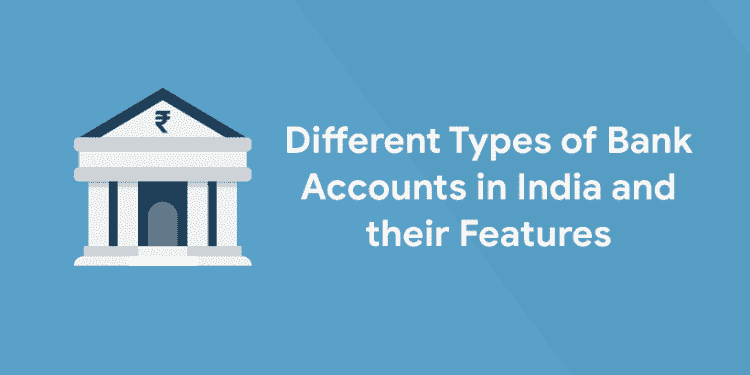Table of Contents
The barter system of giving jackfruit instead of mangoes has given way to the cash economy. The cash economy is giving way to a cashless economy or digital economy now. The un-liquid cash is rolling out through the bank accounts of different persons in no time. In a single click we can transfer lakhs of money from any part of the world to any part of the world. For making all this possible and smooth everyone needs a bank account. The main feature of the digital economy is the rolling of cash through the bank accounts. The demonetization which occurred on 8th November 2016 has accelerated the process of opening bank accounts and initiating digital transactions. There are different types of bank accounts there. Are you confused about different bank accounts and their features and confused about deciding what is suitable for you? Through this article we discuss the different types of bank accounts in India and their features.
A Quick Overview
A bank account is an account for storing and transferring and investing money for different purposes. The bank accounts are designed for different persons and for different purposes. Each bank may offer many features and different types of account but the main structure of every account will be the same. The different category of accounts and their primary aim can be described as follows.
| Bank Account | Primary Aim
|
| Current Account | Keeping money for a short term. The unlimited amount of money is deposited and transferred frequently. Having low interest rates
|
| Savings Account | The money is deposited as savings. Having a decent interest rate
|
| Overdraft Account | The facility that enables you to draw money from a zero-balance account
|
| Certificate of Deposits | Depositing money for a particular long period with a pretty good enough interest rate. Low risk way of investing money
|
| Demat Account | High risk way of investing money. This account is mandatory for investing in share market and stock exchange |
This can be considered as a brief description about all the bank accounts available in the banks around us. Now let us consider each and every account in detail.
Current Account
1: What does the acronym "ATM" stand for in banking?
This is an account which is primarily targeted at the business persons. In a business transaction there may be a lot of money transferred to different persons and some persons may be keeping the money for a short term in their hands. The frequent amount of earning and investing a lot of money needs a bank account which should not prohibit them from depositing a lot of money today and withdrawing the same tomorrow. For that, a current account is provided. The account will be providing a low interest rate. But there is no restriction on the amount of money that can be deposited and withdrawn without any time restriction on it. The current will be provided by the bank according to the credibility of the applying person.
Download Entri App for Banking Updates
Enroll in Kerala's Top-rated Bank Coaching Program!
Are you ready to take your banking career aspirations to new heights? Join Entri App's Bank Exam Coaching program to kickstart your preparations!
Join Now!Savings Account
This is the most opened bank account by a normal person. This account is for depositing their earnings in a bank for a decent amount of interest. Interest rate may change from year to year and bank to bank. There is no limit of the amount for depositing but sometimes there is some limit of withdrawal from the account. The savings account is used by an earning person to deposit their earnings frequently and to carry out their day to day normal transactions. The savings account is calculated for taxation.
Overdraft Account
This is not a particular account but a facility. If the facility is enabled in a bank account that bank account is usually termed as the overdraft bank account. The overdraft facility is the facility that enables the customer to withdraw money from a zero balanced account. That doesn’t mean that the account always needs to be kept zero. The account is aiming at the persons who actually need more money for transactions than their current balance and are capable of payback immediately. If you are a business person you need 60,000/- extra in this month for a transaction and you have a deficit of 60,000/- you can draw the money using an overdraft facility. You need to pay back the money with some prescribed fees. The overdraft can be considered as a short-term loan with low interest rate given to credible persons. Every one cannot enable overdraft facility. For that the person should be very credible to that bank and having a decent and frequent transaction history before the bank. The overdraft facility is enabled against the current bank account or the saving bank account. In order to enable the overdraft facility, you need to have a current bank account or a savings bank account. Normally it is given to current bank accounts.
Download Entri App for Banking Updates
Certificate of Deposits
Certificate of deposit is another kind of bank account which enables their customers to invest the money in their bank. This is a low risk way of investing the money with a pretty good enough rate of interest available. A particular amount of money is deposited for a particular time. The particular time is called the maturity time of the deposit. One cannot withdraw the money before the maturity period. If he does so, the interest amount will be cancelled. The certificate of deposits can be classified into two.
-
Fixed Deposits
The fixed deposit means a particular amount is fully deposited for a particular maturity time. In certificate deposits, the fixed deposits offer you a great interest rate. The money is deposited as a whole. For example, 1 lakh rupee is deposited for 3 years of maturity time with an interest rate of 7%. By the end of 3 years he will receive 1,21,000/- as total amount. If you withdraw the amount before 3 years you will get only 1 lakh rupees.
-
Recurring Deposit
It is also a certificate deposit where some money is partially deposited consistently for a long particular time. The particular time is the maturity date of the deposit. The term recurring itself means the deposit is reoccurring. In fixed deposit, the money was deposited as a whole but here it is by part. For example, 5000/- rupees can be deposited in every month for a period of 7 years with an interest rate of 5% as recurring deposit.
Enroll in Kerala's Top-rated Bank Coaching Program!
Are you ready to take your banking career aspirations to new heights? Join Entri App's Bank Exam Coaching program to kickstart your preparations!
Join Now!Demat Account
Demat account (short for Dematerialized account) is the most modern account for the high-risk investment of money. It’s not actually a bank account but the facility is provided by the bank also. A Demat account is an account to hold financial securities (equity or debt) in electronic form. In India, Demat accounts are maintained by two depository organisations, National Securities Depository Limited (NSDL) and Central Depository Services Limited (CDSL). A depository participant, such as a bank, acts as an intermediary between the investor and the depository. A Demat account is a mandatory account t required for the share market transactions. It has become significantly important after the introduction of the Depository Act of 1996 for the regulation of the process for sales, purchases and transfers of shares. The Demat account number is quoted for all transactions to enable electronic settlements of trades to take place. Access to the Dematerialized account requires an internet password and a transaction password.
Conclusion
These are the basic bank account systems prevailing in India. The look, name and features of the account may vary from bank to bank and time to time. But the basic structure behind all these banks is still the same. One can open their bank account according to their need and preferences, earning transactions and comfortability.











